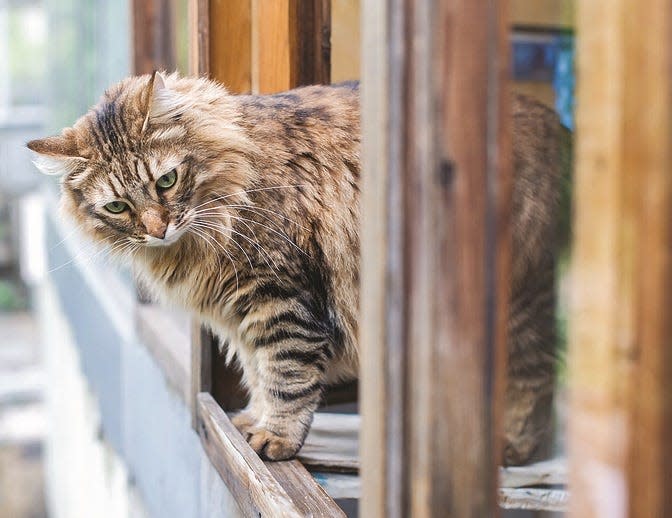Feline Physics: Cats who fall from windows have a surprisingly high survival rate

It’s spring, and cats are falling out of windows. In New York City, at Schwarzman Animal Medical Center, feline high-rise syndrome — defined as a fall from a height of two or more stories — is one of the most common traumas seen.
And it frequently occurs in spring, as the weather gets warmer, and people start opening their often-screenless windows to get some fresh air. Cats with condo fever decide to walk along windowsills, leap after a bird or butterfly, or fall victim to spring fever — the amorous kind that has them seeking a mate.
Some fall just a couple of floors; others from loftier heights, as much as 40 stories, says internal medicine and emergency and critical care specialist Jennifer Prittie, DVM, department head at AMC’s emergency and critical care service. She’s one of the authors of a paper on high-rise syndrome in cats and dogs, published last year in the Journal of Veterinary Emergency Critical Care.
Fortunately, cats have a righting reflex that allows them — if they fall from a great enough height — to instinctively rotate their head toward the ground, then sequentially spiral the rest of the body so their feet are facing downward, too. Once in position, cats reflexively spread their legs, flying squirrel style, arch their back to help reduce the force of impact and relax their muscles. If they’ve had enough time to get into position during the fall, they can stick a four-paw landing.
Even if they land well, though, pets who fall great distances can suffer multiple injuries. Think broken limbs and jaws and collapsed lungs. Long-bone fractures are common, Prittie says. A bruised heart can cause arrhythmias such as tachycardia, a rapid heart rate, or bradycardia — an excessively slow heart rate. Other potential injuries include abdominal bleeding, traumatic brain injuries or a ruptured bladder or pancreas. Cats who don’t show any outward signs of injury still need to get checked by a vet.
The good news for New York City pets is that AMC, a 24/7 level-1 veterinary trauma center, has computed tomography (CT) capabilities and boarded radiologists on hand to interpret scans. The diagnostic test gives a whole-body picture of the animal’s condition, and it’s more comfortable for patients than having to undergo multiple X-rays.
“You can basically get a three-dimensional reconstruction of the entire pet, and that helps with surgical planning,” Prittie says. With it, the veterinary team can evaluate such things as brain swelling or identify injuries such as jaw fractures that may not have been apparent on physical exam.
Animals are usually in shock when they’re brought in; confused, pale and cold; with abnormal heart rhythms, internal bleeding, organ damage and more. Respiratory injuries are often the most immediately life-threatening.
Treatment for high-flying and hard-landing pets may involve stabilizing cardiovascular function, blood transfusions, oxygen therapy, chest tube placement, time on a ventilator, cleaning and bandaging or splinting wounds, pain relief and surgery when necessary. Surgical repair of fractures is usually delayed until more severe injuries are cared for. The survival rate is greater than 90% for both cats and dogs.
While cats are the most commonly reported animals with high-rise syndrome, other animals fall out of windows, too. With dogs, injuries are typically more severe because they are larger and don’t share the feline advantage of a righting reflex and supple spine.
Whether cats or dogs, animals who fall out of windows are usually young and often playing or chasing prey, such as birds or squirrels.
Don’t think it’s safe to leave windows open if you live with a reptile. Prittie once cared for an iguana who had fallen from a height of about 10 stories.
The easiest ways to protect pets? Refrain from feeding birds or squirrels on windowsills, fire escapes or terraces. And most important, screen your windows!
— Kim Campbell Thornton
Do you have a pet question? Send it to askpetconnection@gmail.com or visit Facebook.com/DrMartyBecker. Pet Connection is produced by veterinarian Dr. Marty Becker, journalist Kim Campbell Thornton, and dog trainer/behavior consultant Mikkel Becker. ©2023 Andrews McMeel Syndication
This article originally appeared on South Bend Tribune: Pet Connection: Feline physics and why cats can survive a window fall

